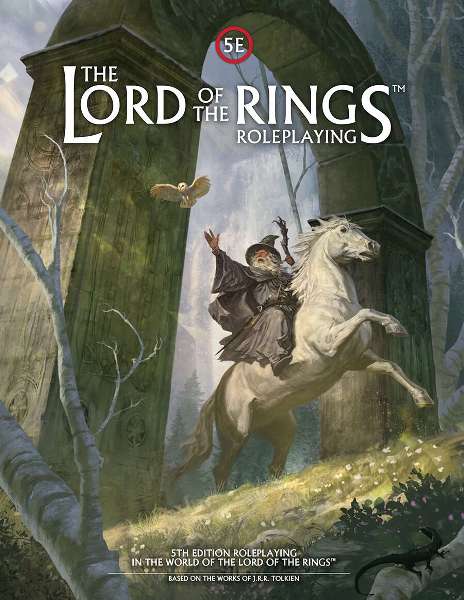
The Lord of the Rings Roleplaying
The Lord of the Rings Roleplaying is an epic fantasy role-playing game written by Francesco Nepitello, Michele Garbuggio, James Michael Spahn, and Jason Durall and published by Free League Publishing.
By Aaron T. Huss

Learn more about The Lord of the Rings Roleplaying here
Purchase The Lord of the Rings Roleplaying here (paid link)
Find other Middle-earth posts here
The Lord of the Rings Roleplaying is a D&D 5e powered version of The One Ring, allowing players to play adventures set in Middle-earth. It replaces much of the high magic, high adventure aspects of D&D with options and mechanics to recreate the types of stories found in The Hobbit and Lord of the Rings. This core rulebook includes everything players and DMs, referred to as the Loremaster, need to play these types of games – character options, gear, setting, adversaries, and mechanics to incorporate the journey into your games. It still requires the Player’s Handbook but provides all other aspects of the game to get started and proceed through years of gaming!
The Lord of the Rings Roleplaying blurb is “5th edition roleplaying in the world of The Lord of the Rings”, but is a horrible representation of the game. While this may seem inconsequential, it is very important in influencing this review and a player’s approach to the game. When I think of D&D 5th edition, I think of high action, high adventure, high magic epic fantasy. None of these are really used to describe Middle-earth. Magic is rare and isolated to specific individuals, most people rarely venture beyond their homeland, very few fantasy cultures exist, action is deadly, and the lands are familiar yet foreign. This RPG is not D&D in Middle-earth, it is a mechanical conversion of The One Ring roleplaying game using the D&D SRD with many new mechanics to represent how games are meant to look and feel in Middle-earth. In other words, it is exactly what I hoped it would be!
The Lord of the Rings Roleplaying strips out a lot of the character creation options and instead focuses on the ones present in Middle-earth – humans, dwarves, hobbits, and elves. Classes are limited to those similar to The One Ring and magic is not available to the PCs. Magical equipment is replaced with what I consider relics with a lot more meaning and purpose behind each one. No generic +1 longswords here! There is a greater focus on cultures represented by Tolkien’s books and there is a greater focus on the journey from place to place plus the fellowship time afterwards. These last two include new mechanics to embrace that style of gameplay.
The setting is the same as The One Ring, set between the events in The Hobbit and Lord of the Rings, with artwork to match that look and feel. The core book includes a bestiary and starting adventure to round out the offering; the bestiary is necessary as the number of different adversaries in Middle-earth is wildly different than standard D&D. This is another reason why the design of the game keeps with the setting and theme instead of going high action crazy. Obviously, The Lord of the Rings Roleplaying is compatible with all D&D 5e material and maybe that is one of it’s greatest draws. You can create a new era in Middle-earth where the lands are opened to new cultures that have never been encountered before. You could use this as a metagame experience where the players put themselves into the roles of those who have never witnessed such creatures before. How do they react? How does the village or town react? How do the invaders interfere with the environment? It’s like allowing the players to experience those first encounters again and narrating how it affects their character. Or you could stick to the setting and maintain your Middle-earth games the way the setting was designed.
So why D&D 5e? Well, given its popularity and how well known the system is, it becomes a more approachable game for many people who just want to experience Middle-earth without learning a new system. I find the mechanics of The One Ring are better suited to the type of gameplay that represents the setting, but that’s just me and there are likely many out there who don’t agree or simply don’t want to learn another system. Regardless, it brings the game’s ability to meet Tolkien’s design to a wider audience, allowing even more people to enjoy it.
I personally do not like vanilla fantasy and love how Middle-earth strips out a lot of the fantastical elements to provide an exciting storytelling and gaming experience. You don’t need to throw everything plus the kitchen sink into a game to make it memorable with endless opportunities. The Lord of the Rings Roleplaying is the perfect balance of story, theme, setting, and mechanics wrapped around a system that most gamers are familiar with. It sticks true to the flavor of Middle-earth while staying in line with the d20 system. It also gives you an opportunity to expand your version of Middle-earth with a landslide of available material.



